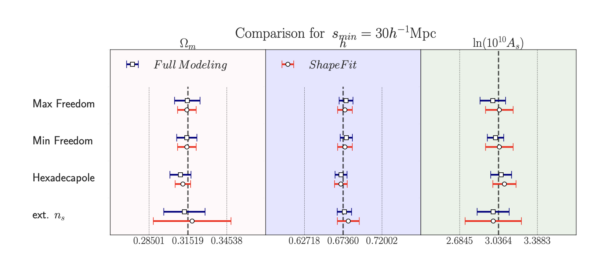In this blogpost we introduce another batch of supporting papers released yesterday on April 11, just one week after releasing our cosmological results using BAO from galaxies and quasars and the Lyman-alpha forest.
Yesterday’s papers do not exhibit new results, but represent major stepping stones towards the cosmology results from the RSD (aka Full Shape) analysis we plan to release soon. They fall into the two categories:
- DESI 2024 II: Sample definitions, characteristics, and two-point clustering statistics.
- DESI 2024 V: Analysis of the full-shape of two-point clustering statistics from galaxies and quasars
DESI 2024 II: Sample definitions, characteristics, and two-point clustering statistics.
These papers describe the methods by which we ensure that all results properly take into account systematic effects, including: incomplete galaxy sampling, human biases, and imaging systematics. For a general overview of how DESI selects its targets, see this blog post, and for more information about survey validation see this blog post.
Most papers attributed to this category are yet to come out. But one of them, the paper presenting the DESI Blinding strategy, was already released yesterday, given its synergy with the BAO papers released a week ago, and with the Full Shape papers also released yesterday. It represents a major stepping stone validating the DESI 2024 Blinding strategy for the BAO and RSD (Full Shape) analysis.
Validating the Galaxy and Quasar catalog-level Blinding Scheme for the DESI 2024 analysis
Corresponding Author: Uendert Andrade
Arxiv: https://arxiv.org/abs/2404.07282
Summary:
Short: This paper introduces the blinding strategy ensuring a data analysis without confirmation bias, validating it using mock catalogs and blinded data.
Long: This paper introduces the galaxy and quasar BAO and RSD blinding scheme, where galaxy redshifts are displaced in two ways, such that overall they mimic i) a dark energy expansion history different than in the fiducial model with cosmological constant and 2) a different growth of structure history corresponding to a different law of gravity. Additionally, galaxy weights are applied to mimic the effect of primordial non-Gaussianity. BAO fits and full-shape fits (ShapeFit) are applied to one realization of Abacus mocks that was blinded according to 16 different varying dark energy and primordial non-Gaussianity scenarios. Additionally, the blinding scheme was applied to the blinded data and validated on that “double-blinded” catalog using BAO fits.
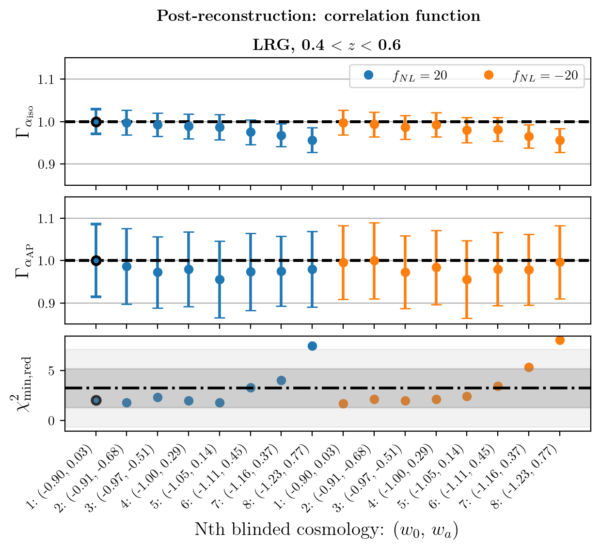
This figure shows for one particular case the fitted isotropic and anisotropic BAO dilation parameters scaled to the expectation obtained from 8 different blindingalues of (w0, wa) and either positive (fnl=20) or negative (fnl=-20) primordial non-Gaussianity. Deviations from 1 are observed only for very extreme pairs of blinding values.
DESI 2024 V: Analysis of the full-shape of two-point clustering statistics from galaxies and quasars
This set of papers document various clustering statistics, modeling, and systematic analysis of DESI’s Year one galaxy and quasar samples. While there is yet more to come out, yesterday’s set of papers focus on the comparison between different Perturbation Theory models (based on Effective Field Theory (EFT)) and codes to the AbacusSummit LRG, ELG and QSO mocks. Overall, they find very good agreement among the different pipelines, corresponding to the Lagrangian and Eulerian Perturbation Theory (LPT and EPT) implementations within Velocileptors, as well as the EFT implementations of PyBird and FOLPSv, where the latter also features an improved model of the impact of massive neutrinos on structure formation.
Furthermore, the papers find excellent agreement between two very different approaches that are used nowadays to infer cosmological information from the full-shape of 2-point clustering statistics:
- Template fits: Here, templates of the two-point statistics at a fixed fiducial cosmology are used to extract physical information from the data, the so-called ‘compressed parameters’ such as the isotropic and anisotropic dilation scales, the growth rate, and the scale-dependence, or shape. The latter is a rather new observable proposed in the ‘ShapeFit’ method, which represents the state-of-the-art method when it comes to template fits. Cosmological parameters are obtained by fitting cosmological models to these compressed parameters measured in each redshift bin. This is very similar to the philosophy behind the BAO analysis, where the (compressed) BAO scaling parameters are measured first in each redshift bin and cosmological parameters are obtained in a second step.
- Full modeling fits: Here, the step of measuring compressed parameters is avoided. Instead, the 2-point statistics of all redshift bins are directly fitted according to the cosmological model. This is similar to the philosophy behind the analysis of cosmic microwave background (CMB) or weak lensing, where the 2-point statistics are also fitted directly, without an additional compression step in between.
Both these approaches have advantages and disadvantages. Template fits are designed to extract only the most robust information and allows for a modular interpretation. For example, they allow us to decouple the information on expansion history, growth history, and shape in an effective way. On the other hand, the extra compression step within the template fit method can erase some of the cosmological information within 2-point statistics. Direct fits allow us to squeeze all of the cosmological information out of the data. At the same time, their results are, by nature, model-dependent, and they do not provide the same means of performing diagnostic tests such as template fits.
For the DESI 2024 Full Shape analysis, we therefore plan to explore both approaches, and yesterday’s papers lay out the pathway of how to carry out both types of analysis in a robust way.
A comparison of effective field theory models of redshift space galaxy power spectra for DESI 2024 and future surveys
Corresponding Authors: Mark Maus, Yan Lai, Hernan E. Noriega and Sadi Ramirez-Solano
arXiv: https://arxiv.org/abs/2404.07272
Summary:
Short: This paper models the redshift-space galaxy power spectrum into the quasi-linear regime with several different EFT models, compares the different models to each other, and tests each using the AbacusSummit simulations.
Long: This paper demonstrates the level of consistency between the different effective field theory models used for fitting galaxy power spectra in redshift space. We show, by fitting to Abacus cubic mocks, that velocileptors (Lagrangian and Eulerian PT versions), PyBird, and FOLPSv give consistent constraints in LCDM and ShapeFit parameters with differences in means of <0.1sigma. We also fit to noiseless theoretical data vectors created by each model while varying scale cuts, and show that for kmax=0.18 h/Mpc the systematic errors are far below the statistical errors for all parameters at precisions corresponding to 8 (Gpc/h)3 volumes.
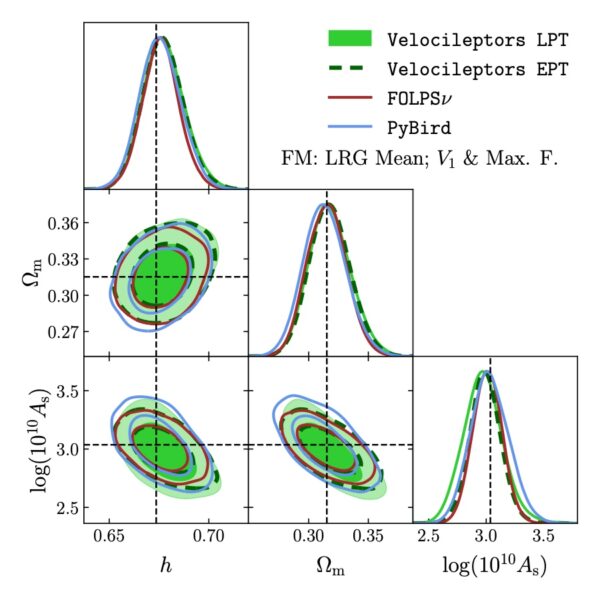
An analysis of parameter compression and full-modeling techniques with Velocileptors for DESI 2024 and beyond
Corresponding author: Mark Maus
arXiv: https://arxiv.org/abs/2404.07312
Summary:
Short: This paper includes validation testing of various features of the analysis using the Velocileptors pipeline in combination with AbacusSummit mocks. Studies the dependence of the results on parameter compression, scale cuts, joint fitting, beyond-Lambda CDM modeling, inclusion of external data, and more.
Long: We present systematics tests and comparisons of three different modeling methods (Full-modeling, ShapeFit, and standard template) within velocileptors for modeling the galaxy power spectrum in redshift space using a Lagrangian effective field theory framework. We fit Abacus N-body simulations created to mimic the LRG, ELG, and QSO tracers that DESI targets, and show that ShapeFit and Full-modeling have consistent constraints and similar constraining power on LCDM models. We demonstrate the behavior of the three modeling methods for a variety of fitting settings with/without including BAO information in order to describe optimal fitting settings for velocileptors for DESI Y1 analyses and beyond.
We demonstrate constraints on the LRG mock data for the three modeling methods in the right panel of Fig. 3, also shown here:
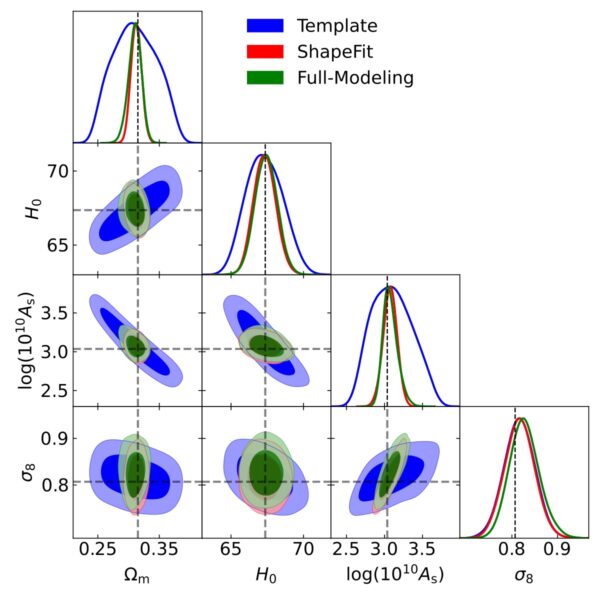
Comparing Compressed and Full-modeling Analyses with FOLPS: Implications for DESI 2024 and beyond
Corresponding author: Hernan E. Noriega
arXiv: https://arxiv.org/abs/2404.07269
Summary:
Short: This paper explores potential sources of systematic error in the full-shape analysis and compression techniques, using the AbacusSummit mocks.
Long: This work validates the robustness of the theoretical modelling of FOLPS, which properly takes into account the presence of massive neutrinos. The study finds that potential modelling errors are fully sub-dominant for DESI’s statistical precision. The research also compares Full-Modeling and ShapeFit fitting approaches, demonstrating their agreement. Overall, this work paves the way for a robust analysis of the DESI power spectrum.
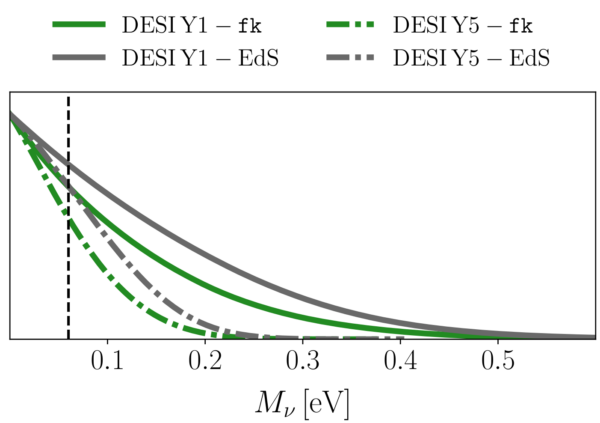
A comparison between Shapefit compression and Full-Modelling method with PyBird for DESI 2024 and beyond
Corresponding author: Yan Lai
arXiv: https://arxiv.org/abs/2404.07283
Summary:
Short: This paper shows that the Shapefit compression matches cosmological constraints using traditional full-shape analysis for ΛCDM, wCDM, and oCDM models.
Long: In this paper, we compare the constraints of cosmological parameters from Shapefit and Full-Modelling with PyBird. We do this with the DESI cubic box mocks for Luminous Red galaxies (LRG), Emission Line Galaxies (ELG), and Quasi Steller Object (QSO) for the LCDM, wCDM, and oCDM models. We found for all three cosmological models tested, the constraints from Shapefit and Full-Shape are consistent with each other. Furthermore, the constraints from both methodologies agree with the underlying cosmology.
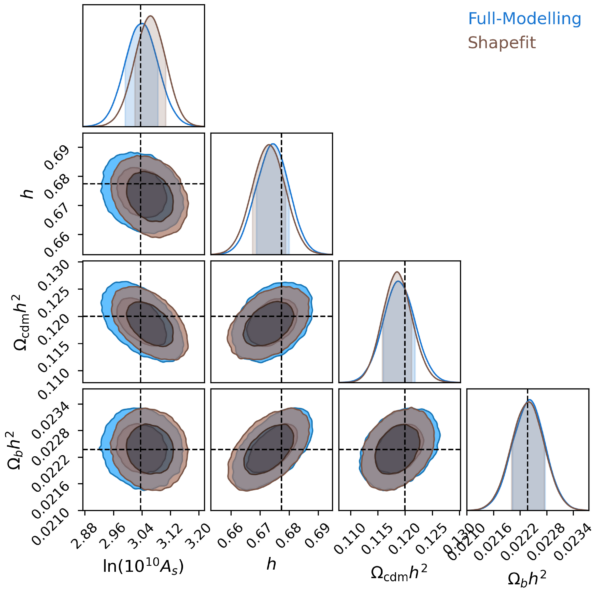
Full Modeling and Parameter Compression Methods in configuration space for DESI 2024 and beyond
Corresponding author: Sadi Ramirez-Solano
arXiv: https://arxiv.org/abs/2404.07268
Summary:
Short: This paper includes similar studies as the other projects in this group, but for configuration space
Long: This work conducts a thorough comparison of various methodologies for modeling the full shape of the two-point statistics in configuration space. We investigate the performance of both direct fits (Full-Modeling) and the parameter compression approaches (ShapeFit and Standard) with CLPT-EFT. Our pipeline recovers unbiased cosmological parameter values for a 1-year DESI volume. We also present the comparisons of the configuration space version of different EFT models.
